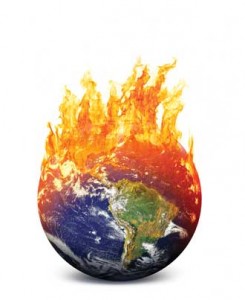In February 2007, the Intergovernmental Panel on Climate Change released its fourth assessment of the Science of Climate Change and concluded that human activity was changing Earth’s atmosphere and, as a result, its climate. It said there was a 95-per-cent chance our mean global temperature would be, by the end of the 21st Century, 1.4 to 4.8 oC above that of the mid-19th Century.
It is very likely the panel’s conclusions are conservative because we now know, based on the results of the Global Carbon Project, that all the emissions scenarios used in the 2007 IPCC assessment reports were lower than what is actually occurring – the effect of the rapid rise, energy- and carbon intensity-based growth in the Asian economy was underestimated. Observations of several key indicators of the climate system, like the extent and duration of sea-ice melt and the rate at which ice is being lost in the Greenland ice cap, also indicate projections from that report were conservative.
So, unlike the talks leading up to the United Nations climate change conference in Copenhagen next month, actual change in the climate continues to progress.
Underlying the science, economics and politics of climate change, is the need to avoid what is considered “dangerous climate change.” This has been defined as general adverse and non-revocable changes in our ecosystems.
There has been considerable discussion among scientists about what atmospheric concentrations of CO2 and other greenhouse gases would push us into the danger zone. It had been thought a concentration of 550 parts per million of what are called CO2 equivalents (the sum of effect CO2 and other GHGs) – roughly a doubling of pre-industrial concentrations – could keep us below this danger threshold. But recent work on the sensitivity of climate models and an examination of past climate records preserved in the ice cores indicate a much lower concentration – about 450 ppm and, some even argue, about 350 ppm – is dangerous.
Our current concentration of CO2 is greater than 387 ppm and, taken with other GHGs, we’ve already surpassed a CO2 equivalent concentration of 400 ppm.
If we’re not in the danger zone already, we’re very close to it.
The obvious way to pull back from dangerous climate change is to cut emissions – but the science indicates that we need to begin to reduce emissions immediately and by the end of the 21st century they would have to be cut well over 70 per cent of their current level. This a very daunting challenge! The Kyoto Protocol was supposed to begin reducting emissions in developed countries, but the reality is that emissions are about 30 per cent greater now than they were in 1990. We’re going in the wrong direction. The prospects for the upcoming 15th Conference of Parties to the UN Framework Convention on Climate Change in December in Copenhagen do not look much brighter.
With the confluence of our failure to achieve any significant reductions in GHG emissions and the prospect of dangerous climate change rapidly approaching, some have begun to suggest we need to intervene directly in our climate through what is called geo-engineering.
Such suggestions have been around for decades, but the possibility of geo-engineering the climate began to get serious attention when Paul Crutzen, the co-winner of the 1995 Nobel prize in chemistry, proposed putting aerosols into the atmosphere to reduce the amount of sunlight reaching the lower atmosphere. This, the theory goes, would produce a cooling effect. In fact, we do this inadvertently already with emissions of sulphate from burning fossil fuels and smelting some minerals – but sulphate is a major culprit in acid rain.
Other proposals look to reduce incoming sunlight, such as mirrors or increasing the surface reflectivity of the Earth, while a much different set of proposals looks at removing excess CO2 from the atmosphere and burying it in the Earth’s crust, or deep in the oceans.
With much foresight, the Royal Society of London initiated a public discussion on geo-engineering with the release of Geoengineering the Climate: Science, Governance and Uncertainty, at the beginning of September. And the U.S. Congress announced last month it would begin discussions of geo-engineering – but there has been no widespread public debate. In Canada there has been no such discussions, with the exception of the upcoming Lorne Trottier Public Science Symposium on Avoiding Dangerous Climate Change at McGill University here in Montreal on Nov. 19.
There should be. If climate change is worthy of debate, certainly the prospect of deliberate human intervention into the Earth’s climate system is something we ought to talk about before someone goes ahead and tries it. Geo-engineering raises many scientific, environmental, economic and ethical questions: Are the proposed technologies actually feasible? How do we separate reality from science fiction? What are the anticipated and unanticipated risks involved? If we invest in geo-engineering will this lead people to believe there is an alternative technological fix that will then make them believe we don’t have to try and reduce our emissions after all? What are the geopolitical implications that arise because advanced countries could make a unilateral decision to embark on geo-engineering?
Everyone needs to become engaged and think very hard about the choices we face as we confront these two very inconvenient truths: the planet is getting warmer and we’re doing precious little to stop it.
Nigel Roulet is the James McGill Professor in the Department of Geography and moderator of the Nov. 19 Lorne Trottier Public Science Symposium.

